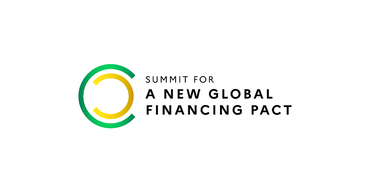Part of the topic :
Summit on a New Global Financing Pact.
- We have just concluded an historic summit on international solidarity. We are clear about our goal: a world where poverty is eliminated and the planet preserved; a world where vulnerable countries are better equipped to face the crises from climate change and conflicts. We are clear about our strategy: leverage all sources of finance, including official development assistance, domestic resources, and private investment.
- To deliver on our goals, we need to stay united. To prevent fragmentation, we will transform the governance of the international financial architecture to make it more efficient, more equitable, and fit for the world of today.
- We have identified four guiding principles that will help us achieve this objective:
• No country should have to choose between fighting poverty and fighting for the planet.
• Country ownership of transition strategies: facing different needs, countries may need to pursue diverse transition paths while coming together to meet the goals of the Paris Agreement. We are accelerating Just Energy Transition Partnerships and Country Packages for Forest, Climate and Nature.
• We need a financial stimulus with more resources to support vulnerable economies lifting their population out of poverty while protecting the planet.
• An international financial system that delivers more: the role of private capital. Meeting global challenges will crucially depend on the scaling up of private capital flows to transform emerging and developing economies, for a net-zero and nature-positive world and to reduce inequalities more efficiently.
- Overall, we need a strong financial stimulus to back the concrete measures that we have agreed or advanced at the Summit:
• We have achieved the target of 100 billion dollars SDR (or equivalent contributions) to be channeled to the most vulnerable countries, especially in Africa, and call for additional pledges. We call on governments able to do so to work on further SDR rechanneling mechanisms.
• There is now a good likelihood that we will reach our target of 100 billion dollars of climate finance this year. We will closely monitor this target and ensure that most vulnerable countries access their fair share.
• We need to be more efficient. Each dollar of lending by MDBs should be complemented by at least one dollar of private finance. Based on this, we expect from them to leverage at least 100 billion dollars of private money each year in developing and emerging economies.
• We also expect an overall increase of 200 billion dollars of MDBs’ lending capacity over the next ten years by optimizing their balance sheets and taking more risks. If these reforms are implemented, MDBs may need more capital. We will also cooperate to boost the investment for a list of major infrastructure projects in Africa.
• We need to accelerate debt suspension and treatments when needed, including to increase the fiscal space of countries in debt distress. We will deliver on the common framework as we did for Chad and Zambia. We also need to support each other when one is hit by a disaster. That calls for specific tools including climate resilient debt clause.
• We need all financial institutions and actors to work together. We will coordinate our MDBs and public development banks for in the Finance in Common network. We will cooperate on energy transition through the Climate Club. - Further work will be advanced working with G20 and COP presidencies on the following areas:
• New avenues for international taxation in order to fulfil our climate commitments. We will also work to take back control on financial flows that escape legitimate tax systems.
• We will promote fair partnerships, in order to develop added value by transforming raw material and critical minerals locally, and reinforce our commitment to deploy healthcare and food infrastructures to increase sovereignty.
• An ambitious replenishment of IDA to keep and increase funding of the most concessional facilities of the World Bank and the IMF.
• Including climate vulnerability in debt sustainability assessments of the World Bank and the IMF, including to enable more investment in adaptation to climate change.
• Ways to mitigate or reduce excess perceived risk, in particular foreign exchange.
• A new international finance facility for forests to pay for ecosystem services, with a goal to invest capital on the market and grant excess return to committed countries.
- To ensure that commitments translate into concrete achievements, we will introduce a joint working committee including international and regional organizations, countries and civil societies to follow this roadmap. We will meet again in Paris, before COP30, to take stock of these commitments.
Summary of discussions at the Summit
Proposed roadmap to build on key milestones of the international agenda as a follow-up to the Summit
Latest news
See all articles and topics-
18 November 2025 Summit on European Digital Sovereignty in Berlin.

-
18 November 2025 Fairer Markets in Support of Digital Sovereignty.

-
18 November 2025 Achieving Europe’s Cloud and Data Sovereignty.

-
5 December 2025 Joint Statement between the French Republic and the People’s Republic of China on Cooperation in Addressing Global Climate and Environmental Challenges.

